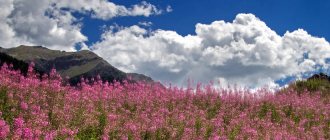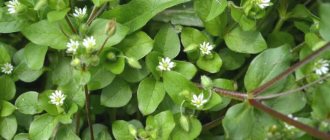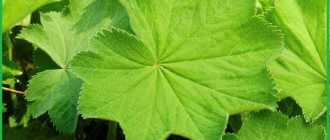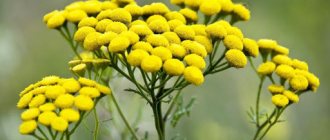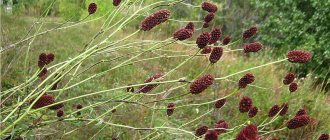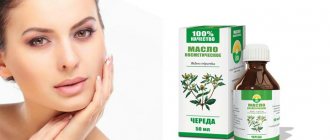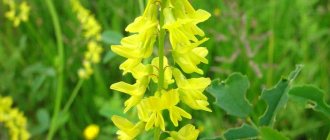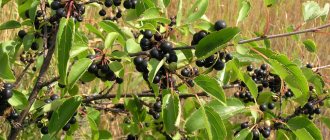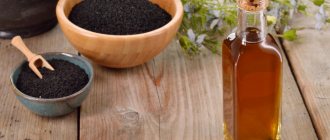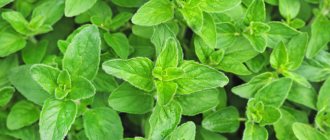People have come up with many names for knotweed: bird knotweed, murava, bird buckwheat, goose grass, ostudnik, hernia grass, trampling grass, goose grass.
It received its most common name for its ability to quickly, “quickly” grow back after damage and mowing.
Appearance
Every villager knows from childhood what knotweed grass looks like. This is an annual plant up to 60 cm tall, but usually spreads along the ground, so it is perceived as shorter.
The stem is highly branched, with pronounced nodes, and becomes hard after flowering. The leaves are small, elliptical or oblong.
In spring, the leaves have a soft emerald hue, in summer they become dark green with a grayish tint, and by autumn they become ocher. Very small white or pink flowers sit in the axils of the leaves.
It blooms all summer and half of autumn, the peak of flowering depends on the area, on average it occurs in July.
The fruit is a small nut with three sides from brown to black. You will probably remember knotweed grass if you look at the photo.
Price of knotweed in a pharmacy
If possible, it is recommended to harvest the grass yourself. The medicinal plant knotweed is sold in pharmacies without prescriptions. Can be purchased through online stores that specialize in such products. The price range in rubles for Moscow is:
| Release form | Quantity | Price range, rub. |
| Filter packages | 20 pieces 1.5 g each | 70-124 |
| Package | 50 g | 40-75 |
Places of growth
In the territory of the former USSR, the knotweed grows everywhere except the Arctic.
Most often it can be found in meadows, wastelands, banks of reservoirs, near roads and residential buildings. It is undemanding to soil composition and moisture conditions, and can even grow on clay and gravel.
What is knotweed
A creeping herbaceous plant has elastic stems, it is pleasant to run on it or walk barefoot. Sometimes it has the appearance of a bush and forms dense thickets. Due to the spread of the grass throughout the country, knotweed has many other names. The most famous of them is the popular name knotweed. In addition, there are:
- grass-ant;
- bird rich;
- buckwheat;
- goose house;
- chicken beetle;
- goose grass;
- bird's buckwheat;
- fringed grass;
- gourd;
- bitter;
- stomper;
- renal;
- cooler;
- chelny grass.
Uses of knotweed
A little about the use of knotweed herb. Previously, dyes were made from this plant: various warm colors were produced from the above-ground part, and blue paint was produced from the underground part.
Ant is excellent for livestock feed; birds especially love it, which is reflected in some variations of the name.
In the cuisines of many nations, young shoots are added to various hot dishes, salads and baked goods.Greens are added to soups at the end of cooking so that the knotweed herb retains its beneficial properties.
Contraindications and precautions
Despite recommendations for using knotweed herb to increase the likelihood of conception, you should not drink it during pregnancy, as it increases the tone of the uterus, which creates a risk of miscarriage.
- Lyubka bifolia - medicinal properties and the best recipes from traditional medicine (110 photos)
- Jaundice - description of the plant, medicinal properties and features of use in folk medicine (80 photos)
Field thistle - medicinal properties, recipes, uses and contraindications of thistle (video + photo)
This medicine is not suitable for hypotensive patients either, because it lowers blood pressure. It can also be harmful in acute kidney diseases.
Herbal medicine, like any treatment, requires prior consultation with a doctor. A specialist will help you figure out whether you have contraindications to the use of knotweed herb.
How to take it correctly
Traditional healers offer a wide range of recipes for treating diseases using knotweed. Each of them contains its own dosage and rules of use. To avoid side effects, you must strictly adhere to the recipe. There are generally accepted patterns of use of medicines based on bird buckwheat:
- drink the infusion half a glass 20 minutes before meals;
- Drink 15 ml of the decoction three times a day;
- The tincture is taken 4 times a day, adding 20 drops to 50 ml of boiled cold water.
In the treatment of infertility
If a woman cannot become pregnant, the use of a decoction is recommended for both partners. The composition is drunk in a glass before meals, 3 times a day. To prepare, add 4 tablespoons of the herb to a liter of boiling water. A woman needs to start taking the decoction one day after the end of menstruation. The medicinal composition helps with infertility:
- relieves inflammation in the pelvic area;
- stimulates the functioning of the ovaries;
- counteracts stress;
- eliminates psychological stress.
Knotweed during pregnancy
While expecting a child, using a medicinal plant in any form is strictly prohibited. This is due to the properties of bird buckwheat. During pregnancy, the use of herbal formulations can:
- cause uterine bleeding that threatens the life of the fetus and mother;
- provoke miscarriage, premature birth, as it has the property of contracting the muscles of the uterus.
For kidneys and liver
To painlessly and gently cleanse the kidneys and treat a diseased liver, healers recommend making an infusion. It helps remove toxins, waste, sand from the organs, and dissolve small stones. It is recommended to drink the freshly prepared infusion, chilled, in the morning, one glass at a time. It is advisable to coordinate the treatment with the doctor to avoid troubles. For cooking in a water bath:
- take a spoonful of herbs;
- pour a glass of boiling water, soak in the bath for half an hour;
- strain.
Infusion for men
The medicinal herb successfully solves men's health problems. It is only important to follow the prescribed dosage to avoid complications. Take the medicinal infusion daily until the symptoms of the disease disappear. A glass of grass is poured with a liter of boiling water and kept covered for 2 hours. Drink 50 ml three times a day before meals. The composition helps:
- normalize sexual function;
- cure peptic ulcer;
- increase vitality;
- treat inflammation of the genitourinary system.
Goose grass for children
Knotweed is used in the treatment of diseases in childhood. The plant is useful for whooping cough and convulsions. The drugs calm the nervous system, relieve fears, and help with high fever. Decoctions are used to lubricate scratches, wounds, and abrasions. It is recommended to take the following medications:
- For cough - decoction with milk. Add 2 tablespoons of herb to half a liter, boil for 5 minutes, drink half a glass 4 times a day. Take until the condition improves.
- Teenagers with acne drink knotweed tea for a month. The course is conducted in spring and autumn.
Self-harvesting knotweed
Bird knotweed is stored during flowering. The top 30 cm of shoots need to be mowed or cut off, leaving the lower hard part.
Contaminated areas and pastures are not suitable for harvesting medicinal raw materials. The farther the collection site is from roads and industrial enterprises, the better.
The cut parts of the plants are laid out in a thin layer in a warm, shaded place and dried until brittle, turning over periodically.
Store dried knotweed in fabric bags or jars with a ventilated lid for up to 3 years. Stocks of nondescript ants will come to the rescue in case of illness.
Photo of knotweed grass
Read here! Snake knotweed - description, recipes, use, properties and contraindications for use (105 photos)
Please repost
0
